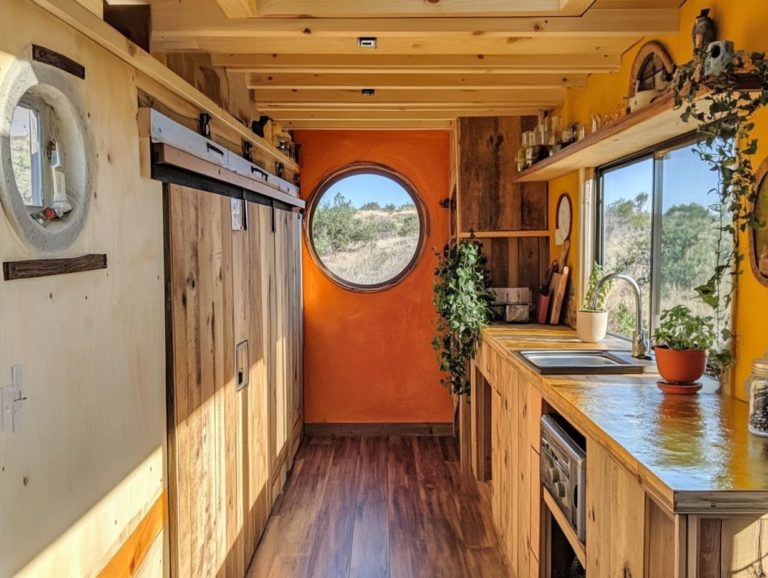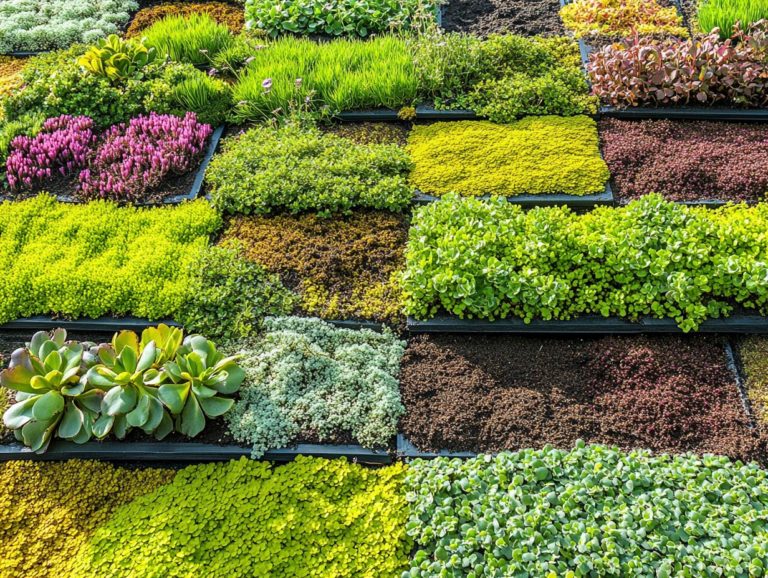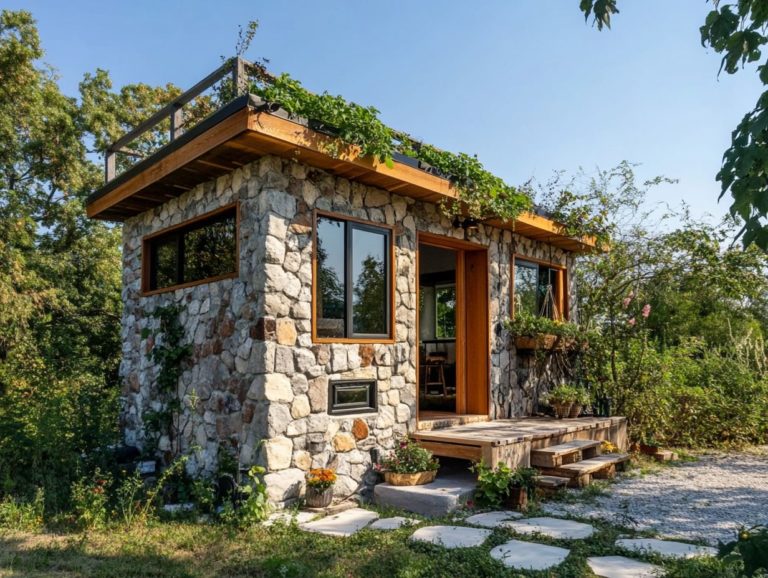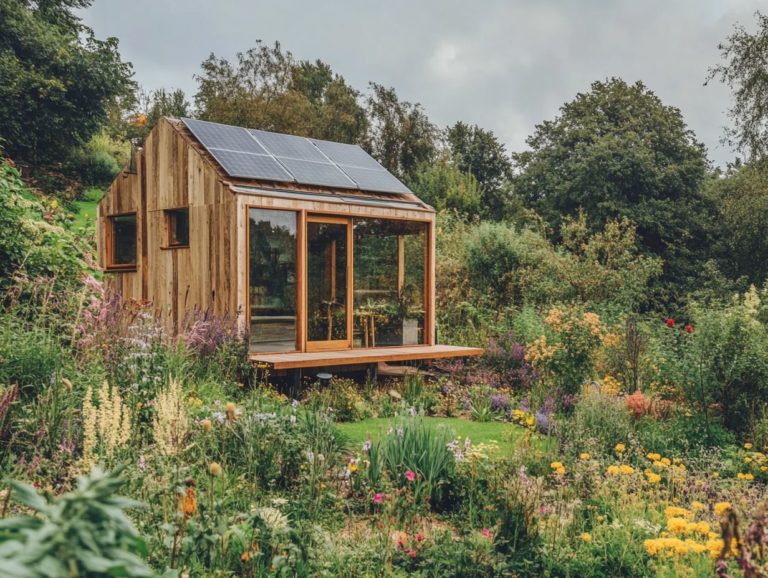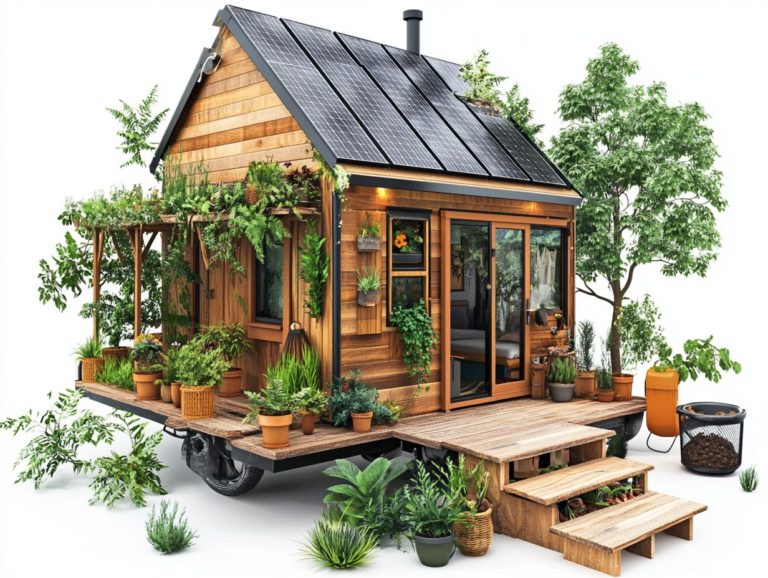Green Certifications for Sustainable Tiny House Materials
In an era where sustainable living is on the rise, tiny houses present a remarkable opportunity for you to embrace eco-friendly principles without compromising on comfort or style.
This article delves into the significance of green certifications for tiny house materials. It showcases the numerous benefits of utilizing sustainable resources from environmental perks to financial savings.
You ll explore various types of certifications, receive expert guidance on selecting the finest green materials, and navigate the challenges that may arise with these certifications.
Make smart choices to enhance your tiny living experience and help create a healthier planet!
Contents [hide]
- Key Takeaways:
- Benefits of Using Sustainable Materials in Tiny Houses
- Types of Green Certifications for Tiny House Materials
- Selecting the Best Green Materials for Your Tiny Home
- Challenges and Limitations of Green Certifications
- Frequently Asked Questions
- What are Green Certifications for Sustainable Tiny House Materials?
- Why are Green Certifications important for Tiny House Materials?
- What are some examples of Green Certifications for Sustainable Tiny House Materials?
- How do Green Certifications benefit the environment?
- Are Green Certifications only for new materials or can they also be applied to recycled or reused materials?
- How do I know if a Tiny House material has an Environmentally Friendly Certification?
Key Takeaways:
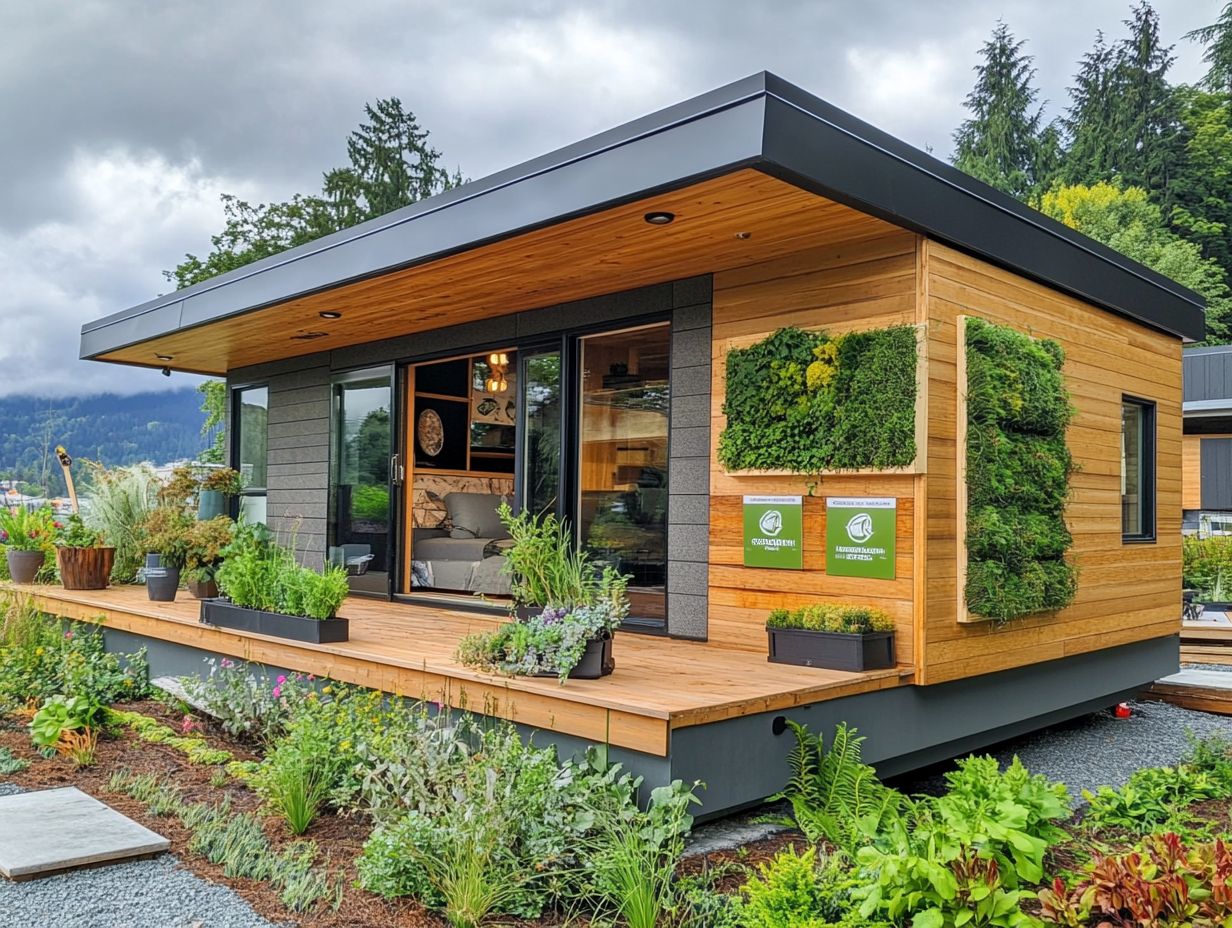
- Green certifications ensure that materials used in tiny houses are sustainable, reducing their environmental impact and saving costs in the long run.
- LEED, Energy Star, and Cradle to Cradle are some certifications to look for when choosing sustainable materials for your tiny house.
- Challenges exist with green certifications, but you should prioritize using certified materials in your tiny house for a greener future.
What are Green Certifications?
Green certifications are essential tools for validating and promoting sustainability in the built environment, particularly in green building. Green building refers to designing and constructing buildings that are environmentally friendly and resource-efficient.
Certifications like LEED and Energy Star focus on energy efficiency and resource management. They help improve occupant well-being and increase property values.
Organizations such as the U.S. Green Building Council and the International WELL Building Institute advocate for eco-friendly materials and practices in commercial real estate, promoting standards that help reduce the carbon footprint.
By prioritizing energy-efficient systems and sustainable materials, these certifications improve your property s environmental profile and lead to decreased operating costs a compelling selling point for potential investors.
For instance, properties certified under BREEAM can demonstrate significantly lower energy consumption and improved waste management practices, boosting their appeal.
Tenants are increasingly savvy to the benefits of occupying green-certified spaces, as these often translate to better air quality and enhanced comfort. The overall impact of these certifications enhances the experience for immediate occupants and contributes to broader community goals, such as reducing the total amount of greenhouse gases produced directly or indirectly by our activities and fostering a healthier urban ecosystem.
Benefits of Using Sustainable Materials in Tiny Houses
Incorporating sustainable materials in tiny houses supports environmental well-being and elevates the overall living experience for you, the resident. This aligns with the principles laid out by the National Association of Home Builders.
By choosing eco-friendly materials, these homes can significantly reduce their carbon footprint while enhancing water efficiency and resource efficiency, in line with best practices from organizations like the Building Research Establishment.
This approach fosters healthier indoor air quality, vital for your well-being, all while aligning seamlessly with contemporary sustainability trends.
Start your journey towards sustainable tiny living today!
Environmental Benefits
The environmental benefits of using eco-friendly materials in tiny houses play a crucial role in advancing sustainability goals and reducing your carbon footprint. By opting for these materials, you minimize waste and promote getting the best use out of materials. You also enhance water efficiency and improve indoor air quality, creating a healthier living environment for yourself.
Take bamboo and reclaimed wood, for instance. These materials cut down the demand for virgin timber and sequester carbon as they grow. Insulation made from recycled denim and sheep’s wool can dramatically cut your energy costs by improving how well your home keeps heat in or out, meaning you ll rely less on heating and cooling systems.
Choosing low-VOC paints and finishes further elevates your indoor air quality by reducing harmful pollutants. By selecting sustainable options, you can make a meaningful impact on overall greenhouse gas emissions and embrace a lifestyle that benefits both you and the planet.
Cost Savings
The cost savings from using energy-efficient materials in tiny houses can be substantial, resulting in lower utility bills and enhanced property values over time. Environmentally conscious tenants often pay a premium for homes that emphasize energy efficiency and sustainability, ensuring better returns on your investment.
By investing in appliances and insulation that cut down on energy consumption, you reduce your monthly expenses and decrease maintenance costs due to the durability of sustainable materials. For example, high-quality solar panels and efficient heating systems can pay off their initial investment within just a few years. The cumulative savings can be impressive, often leading to higher appraisals in a competitive housing market.
As more individuals search for homes that align with their values, the allure of tiny houses built with sustainable materials drives up demand, significantly elevating their market presence within the commercial real estate landscape.
Types of Green Certifications for Tiny House Materials
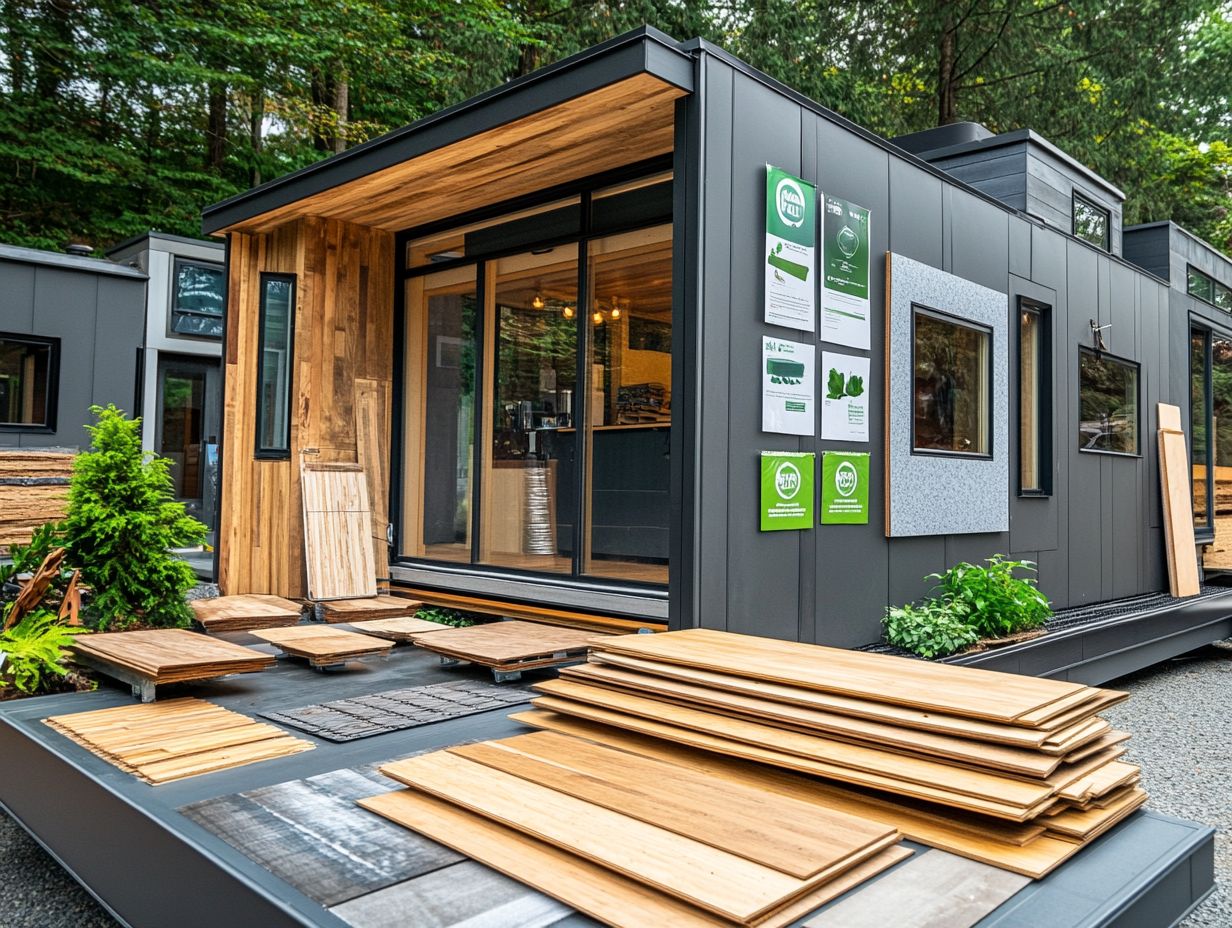
When selecting sustainable materials for tiny houses, you ll encounter a range of green certifications that can guide your choices and help you adhere to stringent environmental standards.
LEED certification stands out as a prestigious mark of sustainability, renowned for its thorough and holistic approach. If energy efficiency is your primary concern, Energy Star certification specifically focuses on that.
Consider Cradle to Cradle for its eco-friendly focus, Green Globes, and the National Green Building Standard (NGBS), which provides a more adaptable framework for sustainable building.
By leveraging these certifications, you can ensure your tiny house embodies both quality and environmental responsibility.
LEED Certification
LEED certification, established by the U.S. Green Buildings Council, stands as a premier benchmark for sustainability in building and design. It emphasizes energy efficiency, water efficiency, and indoor air quality. Meeting its rigorous standards allows tiny houses to gain recognition that enhances their value and attracts environmentally conscious tenants.
This certification demands strict adherence to criteria, such as incorporating energy-efficient appliances, utilizing renewable energy sources, and implementing rainwater harvesting systems to reduce resource consumption. Choosing sustainable materials, such as reclaimed wood, and ensuring high-quality insulation can significantly enhance a tiny house’s performance under LEED standards.
These sustainable practices resonate with a growing community that prioritizes ecological responsibility and sustainability, nurturing a lifestyle that is both modern and attuned to the planet’s needs.
Act now to invest in sustainable materials for your tiny house and make a positive impact!
Energy Star Certification
Energy Star certification, proudly endorsed by the Environmental Protection Agency, signifies that your building meets strong energy-saving standards. This leads to substantial cost savings for you and your tenants and aligns with an increasingly eco-conscious market. For tiny houses, achieving this certification can enhance sustainability while attracting those keen on reducing their energy bills.
The benefits of this certification extend beyond immediate financial relief; they promote a more environmentally sustainable lifestyle. Energy-efficient tiny houses consume considerably less energy, resulting in lower utility costs and a reduced carbon footprint. For those interested in construction, using sustainable building materials for tiny homes can further enhance your positive impact. You’ll feel great knowing you’re helping the planet!
Energy Star-certified homes often attract buyers who prioritize sustainability, adding an appealing layer of value in an increasingly competitive market. By emphasizing energy efficiency and highlighting the impact of sustainable materials on tiny house value, you position tiny homes as not just an economical choice but also a responsible investment in the future of our planet.
Cradle to Cradle Certification
Cradle to Cradle Certification offers a rigorous evaluation of product sustainability, focusing on areas like material health, material reutilization, renewable energy use, and water stewardship. This certification is invaluable for anyone considering eco-friendly materials for tiny houses. It promotes resource efficiency and champions materials that are safe for both the environment and human health.
By following these principles, you can choose materials that align with eco-friendly practices and contribute to a circular economy, a system where materials are reused and recycled. For example, materials such as bamboo flooring and recycled metal roofing stand out for their exceptional health and reutilization, ensuring durability while being sustainable.
Opting for non-toxic paints and finishes can further elevate your living space, enhancing both the environment and personal well-being. Embracing renewable energy systems like solar panels aligns with Cradle to Cradle’s commitment to sustainable energy practices, allowing you to adopt a comprehensive and responsible approach to construction.
Selecting the Best Green Materials for Your Tiny Home
Choosing green certified materials for your tiny house requires careful evaluation of sustainability, resource efficiency, and the eco-friendly options available on the market. With various green certifications to navigate, it’s crucial to choose wisely to align with the specific sustainability objectives of your project.
Factors to Consider
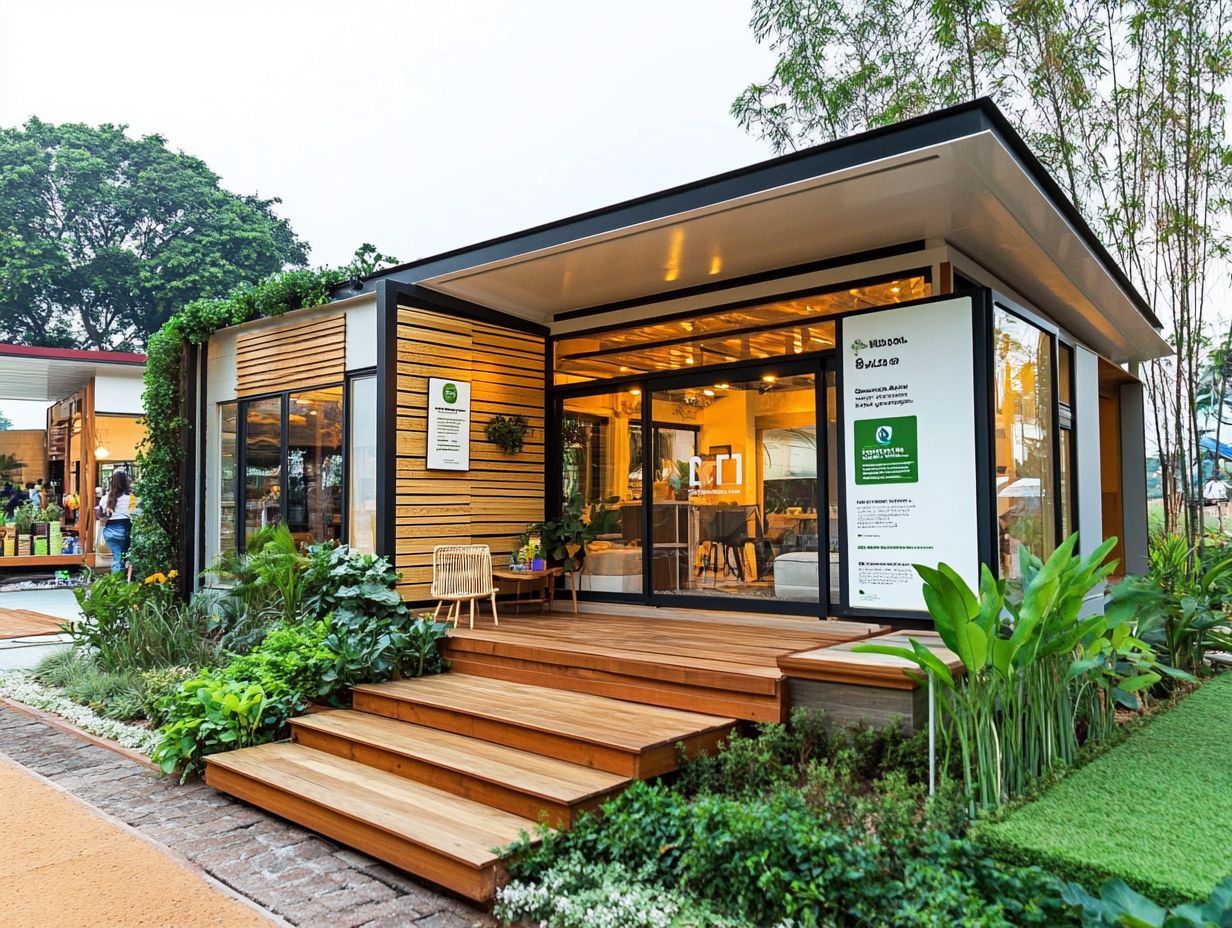
When selecting green certified materials for your tiny house, consider several factors: sustainability, cost, performance, and the availability of eco-friendly options. Evaluating these aspects is crucial to ensure your choices align with both your budget and environmental goals.
Understanding sustainability means diving into how materials are sourced, processed, and their overall lifecycle impact. Start by researching certifications like FSC, which signifies responsible forestry practices.
For cost-effectiveness, compare the long-term savings of energy-efficient materials to their initial costs. Sometimes a higher upfront investment can lead to significant savings down the road.
Performance is another key factor, relating to the durability and energy efficiency of the materials you choose. Aim for options that provide excellent thermal insulation while minimizing environmental impact.
Lastly, ensure eco-friendly materials are readily available in your area. This will streamline procurement and help you reduce your carbon footprint during transport.
Challenges and Limitations of Green Certifications
Despite the myriad benefits of green certifications, you may encounter challenges and limitations that could impede their widespread adoption. High certification costs, complex application processes, and a lack of awareness among builders and consumers can all pose significant barriers, preventing the full realization of sustainability’s potential in construction.
Start your journey toward a sustainable tiny house today!
Obstacles to Overcome
Obstacles like high costs and limited awareness of green certifications are significant barriers for builders and homeowners striving for sustainability. Overcoming these challenges is crucial for encouraging broader adoption of eco-friendly practices.
Financial constraints often arise from the upfront costs of obtaining certifications and investing in sustainable materials. This can deter many from making the leap.
Many individuals, including construction professionals, lack education on the long-term benefits and returns on investment associated with green certifications. This gap breeds skepticism, stalling progress.
Let’s tackle these financial and educational gaps head-on! Enhanced training programs and financial incentives could empower builders and homeowners to embrace green options, paving the way for a more sustainable future.
The Importance of Using Green Certified Materials in Tiny Houses
Using green certified materials in tiny houses is vital for promoting sustainability and enhancing environmental health. By choosing these materials, you improve the living experience in your tiny home and meet the growing demand for eco-friendly construction practices.
When you incorporate sustainable options like reclaimed wood, low-VOC paints, and energy-efficient insulation, you create spaces that minimize waste and reduce your carbon footprint. To learn more about sourcing these materials effectively, check out how to source sustainable materials for your tiny home. This commitment benefits you by providing healthier indoor air quality and lowering utility costs.
When communities prioritize green certifications, they conserve natural resources, promote biodiversity, and help fight against climate change. Choosing green certified materials, especially in construction, is a crucial step toward a sustainable future for everyone.
Frequently Asked Questions
What are Green Certifications for Sustainable Tiny House Materials?
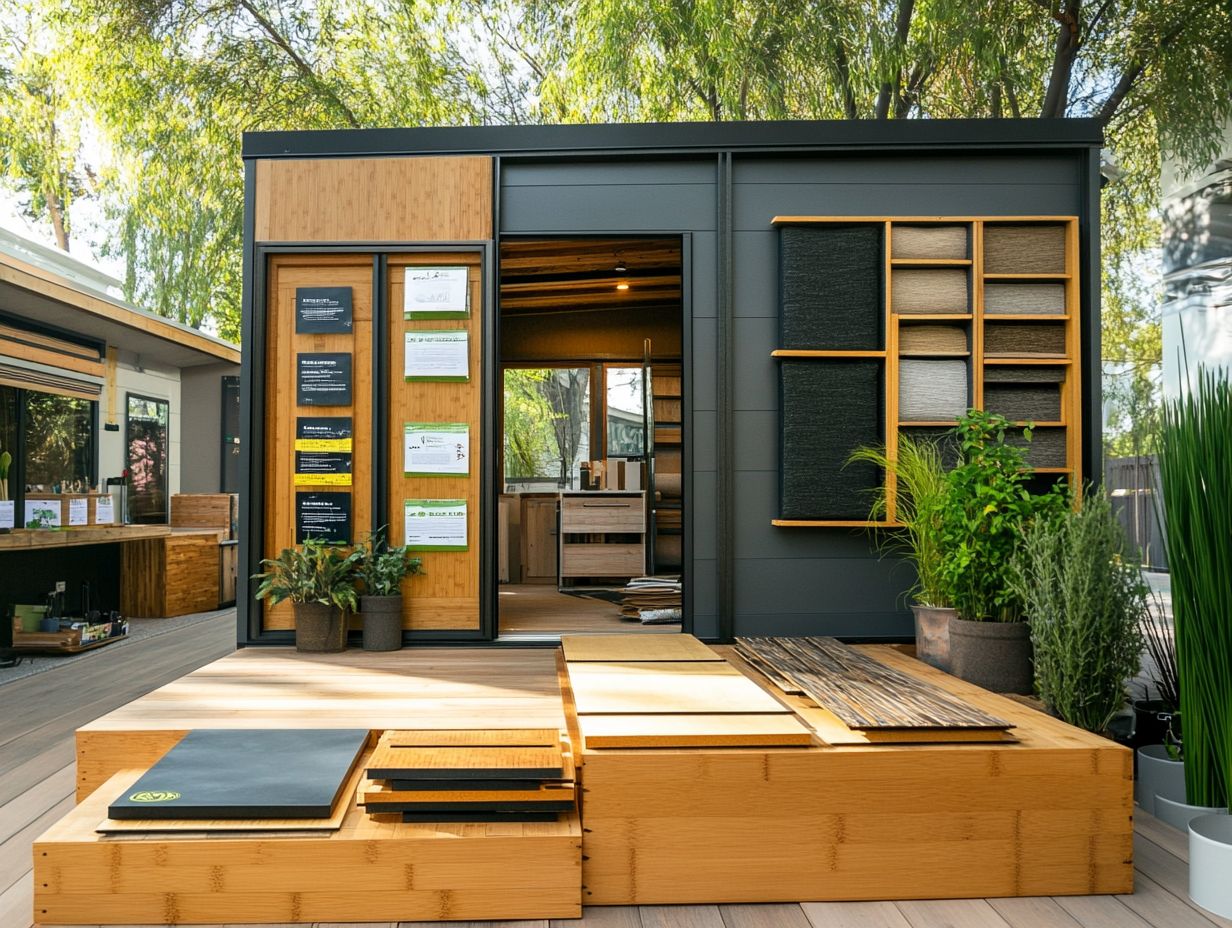
Green Certifications are labels given to building materials that meet certain environmental standards. They ensure that materials used in tiny house construction are sustainable and have minimal negative impacts on the environment.
Why are Green Certifications important for Tiny House Materials?
These certifications assure that materials are environmentally friendly and produced using sustainable methods. They help consumers make informed decisions about their choices.
What are some examples of Green Certifications for Sustainable Tiny House Materials?
Examples include LEED (Leadership in Energy and Environmental Design), FSC (Forest Stewardship Council), and Energy Star. These certifications evaluate aspects like energy efficiency and environmental impact.
How do Green Certifications benefit the environment?
Green Certifications promote the use of sustainably produced materials, reduce waste, and conserve natural resources. They encourage the development of new, eco-friendly materials.
Are Green Certifications only for new materials or can they also be applied to recycled or reused materials?
They can apply to both new and recycled materials. Many certifications, like LEED, give extra points for using recycled or reclaimed materials in construction projects.
How do I know if a Tiny House material has an Environmentally Friendly Certification?
You can usually find information about a material’s certification on the product’s label or packaging, or on the manufacturer’s website. You can also look up a specific certification on the organization’s website to verify if a material has been certified.
Doing some research and asking questions before purchasing materials for your Tiny House is always a smart move. Using certified materials can help create a healthier living space for you and the environment!

